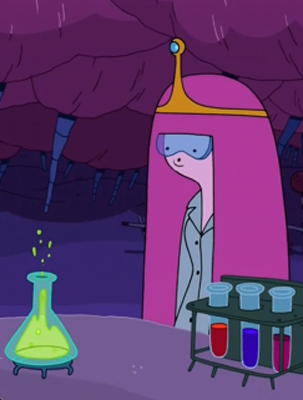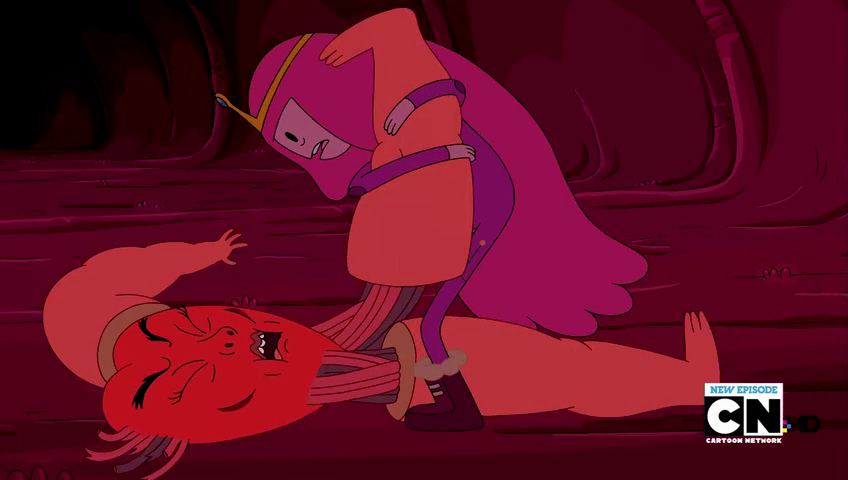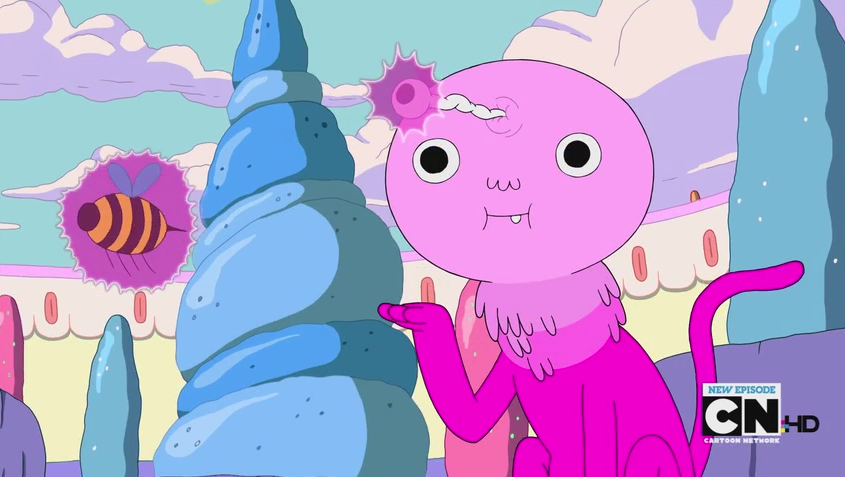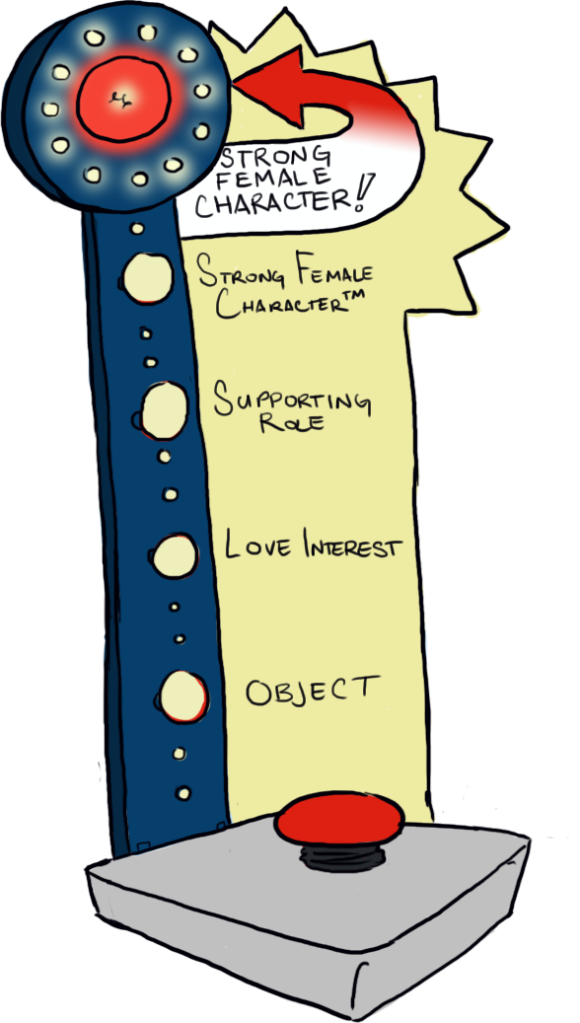Friday, 4 January 2013
She Blinded Me With Science
In our survey of the subversive qualities of the ladies of Adventure Time, it’s only right that we end with Princess Bubblegum. For the better part of three seasons, Princess Bonnibel Bubblegum (hereafter Bubblegum, Bonnibel, Peebles, or just PB) occupies the role traditionally reserved for the princess prize, the woman who will be given to the hero as just deserts for his impressive deeds. Except, of course, that that’s not even remotely what happens.
Just as Marceline operates within and against the conception of vampires derived from literary and folkloric sources, the character of Bonnibel is informed by a long tradition of fairy tale princesses. Her skin, hair, and wardrobe are all overwhelmingly pink. She has a tendency to speak in a formal register, stopping just short of speaking with the royal “we.” She serves as an almost preternaturally all-knowing guide to our hero, and it is her job both to send him off on quests and to ensure that he learns the proper lesson from his adventures. She even bids him farewell by waving a handkerchief.
The handkerchief incident is an excellent indicator as to the show’s approach to Bubblegum’s princess status; when seeing Finn off, she actually stops herself mid-sentence, says, “Wait a minute,” and produces the cloth in order to get the look right. If a princess is sending her hero off, she has to cut a suitably dramatic figure. The same kind of transparency exists in her speech patterns. While she clearly strives to stay in royal character, she also regularly slips into informal diction and slang, mixing declarations that she “will be back on the morrow” (a phrase which, in context, is itself a play on assumptions about formal language) with words like “y’all” and “aight.” Even the lessons she imparts are delivered in unexpected ways. When Finn and Jake disregard signs telling them not to enter a dungeon -- signs that Bubblegum had them put up -- she tries to make them see that the lesson was to obey her orders. The boys offer a different lesson and, when Bubblegum finds it lacking, Finn amends it: “I learned that you are a very... intelligent princess?” Her response? “You’re darn right I am.” As if all this weren’t enough to let us know that we’re dealing with a different kind of princess, the swan she rides can shoot lasers. Because of the show’s post-apocalyptic setting, it almost seems as if Bubblegum has tried to meld her reality with our storytelling tropes, revealing the performativity of princessery in the process.
Further hammering this point home are Bonnibel’s other pursuits. She is a polyglot, speaking German and English as well as understanding Korean. Like the sugar-based lovechild of Pinkie Pie and Marie Curie, she spends her time either attending bizarre events (our particular favourite is the Whistling Choir Death Match Championship) or doing Science (the capital “S” is always implied). We’re most interested in the latter interest, because science has typically been considered masculine territory.
In Adventure Time, however, the first episode opens with Bubblegum conducting an essentially impossible scientific experiment while Finn looks on, fascinated and uncomprehending. It’s a daring move, because the first time we meet Bubblegum, she messes up. In another show, this might set the standard for her character: she tries to perform experiments beyond her ability and Finn saves the day by fighting the monsters that result. Instead, she has him babysit her subjects while she fixes the situation herself. In addition, the problem that she’s trying to solve is death itself, and she triumphs. Accidentally raising a candy-eating zombie hoard from the dead can be overlooked when it leads to unlocking the secret of resurrection.
Adventure Time manages to strike this kind of balance in many aspects of Bubblegum’s character. She is obsessed with science, once going so far as to use a wide variety of scientific approaches and equipment to make “the most perfect sandwich that has ever existed or ever will exist within the confines of space-time.” In this instance and one other, when she stays up for eighty-three hours straight in order to make herself an immortal replacement, the show suggests that this obsession may be unhealthy. At the same time, however, the vast majority of her experiments and inventions are helpful, practical, and just downright cool, and the show actively supports her accomplishments. She also has a tendency to engage in displays of irrational anger, but these moments are tempered by the hyper-rationality that dominates the rest of her life.
Although she often has to be saved, she is clearly able to take care of herself. The best example of this occurs in the episode “Lady and Peebles,” which follows Bubblegum and Lady Rainicorn as they embark on their own adventure to save Finn and Jake from the nightmarish Ricardio the Heart Guy. Not only does PB prepare for every eventuality, but when her equipment is stolen and Lady injured, she nevertheless sets forth to save her friends, all while carrying the much larger Lady on her shoulders. When she discovers that Ricardio has made himself a body and intends to marry her, she agrees, on the condition that he must beat her in hand-to-hand combat. She exploits his body’s poor design, literally ripping him limb from limb before delivering this amazing speech: “You think we’re intellectual equals? It only took me seconds to get you off your guard! And this ‘body’ you’ve designed is self-congratulatory garbage! See, I know a thing or two about building a body out of biomass, and you don’t leave your heart exposed!” When Ricardio protests that he only wanted to impress her, she simply replies, “You didn’t.” Finally, because she hadn’t quite reached a high enough level of BAMFitude, she drags Finn, Jake, Lady Rainicorn, and the Ice King back to the Candy Kingdom, where she cures them and builds the Ice King a new heart. Still, while she combines brains and brawn, she doesn’t quite fit the warrior princess mold. She doesn’t seem to enjoy fighting, using it not to replace, but to support her intellectual smackdowns.
In addition to her duties as princess of the Candy Kingdom, she is queen of the trolls. Not only does she help Jake with his haunted house trick, but she uses her knowledge that Finn wants to kiss her to engage in a little good-natured teasing. She makes a habit of exploiting her connections to a hero to get him to do menial tasks for her, like watching her princess plant or putting up signs. The pièce de résistance is her decision to make Finn and Jake believe that she’ll be decapitated if they don’t deliver tarts to an official ceremony on time, purely to ensure that they won’t eat the tarts themselves.
This attitude toward Finn may explain, at least in part, why they don’t really work as a romantic pairing. While Finn entertains the idea that the (probably several times) eighteen-year-old Bonnibel could come to love his thirteen-year-old self, she seems to understand that they are at different places in their lives. This is confirmed in “Too Young,” when the thirteen-year-old Bubblegum displays feelings for Finn that her older self dismisses as a mere childish whim. He constantly tries to impress her, but she cannot -- or does not let herself -- see his actions as legitimate romantic advances. In fact, her willingness to tease him about wanting to kiss her may stem from her inability to figure out a way to let him down gently. This is suggested by the events of “Incendium,” when Finn puts his head in Bubblegum’s lap and she cannot get away fast enough. Before she goes, she does manage to express how awkward he has made their friendship: “Finn, no. Come on, Finn, don’t be weird.” Finally, when Jake suggests that jealousy lies behind her objection to Finn’s relationship with Flame Princess, she tells him that it’s not about “some petty love triangle.”
Jake speaks here as the voice of narrative convention. In other stories, the girl who’s been resisting the boy’s advances might show interest after he’s moved on, moving him out of the so-called “Friend Zone” only after he’s already left. Adventure Time doesn’t even entertain the idea of friend-zoning, instead replacing it with an increasingly foreign concept we might call “being friends.” What makes this particularly impressive is that it shuts down the easy drama represented by the love triangle in order to show respect to the characterization of all parties involved. It’s a bold move, and as people who would prefer not to have to see another lazy love triangle storyline for about a decade, we appreciate it.
When she’s trying to explain to Finn why he shouldn’t date Flame Princess, Bonnibel makes a particularly revealing argument: “Finn, sometimes you want someone, and you want to kiss them and be with them, but you can’t, because responsibility demands sacrifice.” Regardless of your shipping preferences, this says a lot about her approach to life as a princess. In “Too Young,” she talks about the toll royal responsibility takes, stating that she would love to remain thirteen in order to enjoy the freedom of childhood; however, she ultimately decides to age back into rulership because her people need her, “and that comes first.” She is motivated primarily by a need to do right by her subjects, keeping them in ignorance when it will save their lives and planning to torture the Ice King in order to cure an epidemic. She is a monarch first and a person second.
The most interesting treatment of PB’s approach to leadership comes in the “Goliad” episode. Faced with her own mortality following her near-death at the hands of the Lich, Bubblegum decides to make a successor who can live forever. That successor turns out to be Goliad, a rather horrifying piece of Nightmare Fuel made from Bubblegum’s DNA. Because PB stayed awake for days making the unholy creature, Finn and Jake take Goliad out for her first lesson in leadership. Goliad learns the wrong lesson, claiming that enraged shouting and psychic/telekinetic manipulation are the best ways to get people to do what she wants. When it comes time for Bubblegum to correct her creation’s conception of leadership, she tries to figure it in terms of a symbiotic relationship between ruler and subjects: “Goliad, let me tell you something about leadership. You see this fat bee? She gets pollen from this flower, but she’s gentle and makes the flower happy and pollinated. They both get what they need. And that’s how a leader should be.” Goliad rejects this reality and substitutes her own.
To prevent Goliad from indulging her megalomaniacal tendencies, Bubblegum makes another candy sphinx, this time using Finn’s heroic DNA to make Stormo, a selfless creature willing to sacrifice himself to save the kingdom. Here’s where things get interesting, even though that’s technically where we leave the episode. If we are to infer that Finn’s heroic DNA made Stormo heroic, we have to wonder what Goliad’s actions say about Bonnibel herself. Is it her DNA that produces a creature willing to rule others by force? Or, considering the fact that Goliad initially sees this forceful behaviour demonstrated by Jake, is this merely a comment on the malleability of children’s minds and the necessity of giving them healthy examples to emulate? At the very least, it shows us that Bubblegum is willing to enter ethically dubious territory in equipping her ideal ruler with psychic powers.
What we appreciate about Bubblegum is precisely what we enjoy in all of the Adventure Time characters we discussed: they are successful subversions of familiar character types that demonstrate what you can create when you expand these types into nuanced, fully-formed people. The show gives the lie to the claim that children’s programming is simplistic and unsophisticated. On the contrary, Adventure Time proves that a simple concept can give its creators room to create, to expand upon ideas, situations, and characters that television shows and films intended for adult audiences leave unexplored. It is a cartoon that draws its women in fine detail, rendering them human with all the accompanying strengths and flaws inherent in the term. If enjoying some legitimately strong female characters means that we also have to adjust to a world in which the amount of candy matter present in one’s body determines one’s age and buttermilk is instrumental in summoning demons, we have to say we’re okay with it.
Verdict: Actual strong female character
Edit: Sometimes when you have a deadline looming, you publish work that is less than your best. Luckily, we’re giving ourselves something of an extension to ensure that Princess Bubblegum gets the treatment she deserves.
We have had it brought to our attention by Adventuretitan that we missed a major issue in the “Lady and Peebles” episode. While we focused on Bubblegum’s ability to defend herself, we neglected to discuss what she was defending herself from. From the moment that Bubblegum and Lady Rainicorn enter Ricardio’s lair through a sphincter, the episode is full of the imagery and symbolism of violated bodies. While flying through a dark chamber, Lady and Bubblegum are accosted by a multitude of groping, disembodied hands. After temporarily impairing her sight, the hands strip Bubblegum of her bag of supplies, leaving her vulnerable.
Once she and Lady enter the chamber that houses Ricardio, they are confronted with the body of the Ice King, whose chest bears a gaping wound. Next, they see the unconscious Finn and Jake, who have been poisoned by zanoits, which seem to replicate some of the effects of date rape drugs. Finally, Ricardio reveals the reason for this horrific display: “I thought I only wanted your heart, but I was wrong. I was unfair to you. I want the full package.” He has made himself a body, and the interest he takes in Bubblegum removing some of her clothing suggests that he is planning to use his new body to violate hers.
In light of this, Bubblegum’s ability to best Ricardio on a physical level can be seen not only as a display of badassery, but as an assertion of bodily autonomy. She annihilates his capacity to enact sexual violence, not just preventing a sexual assault, but incapacitating a sexual assailant. Even better is the fact that the narrative upholds her actions as very much the right thing to do.
Another important moment we wanted to discuss occurs in a situation where Bubblegum’s body has actually been compromised. In “Mortal Folly,” Finn uses the power of love (or liking someone a lot) imbued in the sweater Bubblegum made him in order to defeat the Lich. However, when he attempts to use the same sweater -- and, therefore, the same power -- to restore the possessed Bubblegum’s true self, nothing happens. As Finn observes, “Liking her didn’t work. She’s unstoppable.” For once, the power of love isn’t enough to save a woman. We may be jaded as a result of overexposure to Disney movies, where the healing properties of “true love’s kiss” are apparently limitless, but the idea that a woman can have strengths and weaknesses that have nothing to do with romantic emotion is pretty excellent. It’s sad that we even have to celebrate such a thing, but we’re willing to give kudos to any show that does it right when so many do it wrong.
Subscribe to:
Post Comments (Atom)






No comments:
Post a Comment